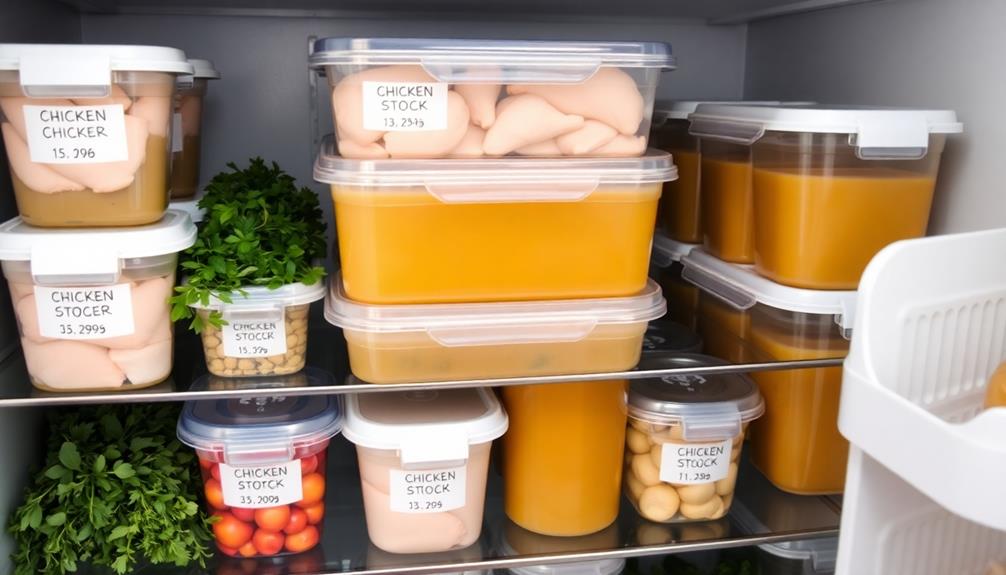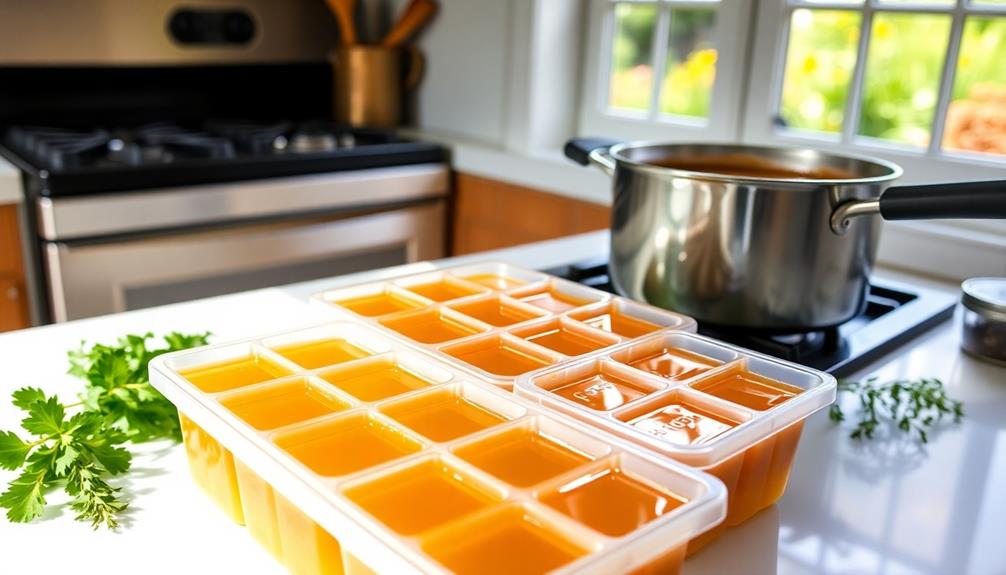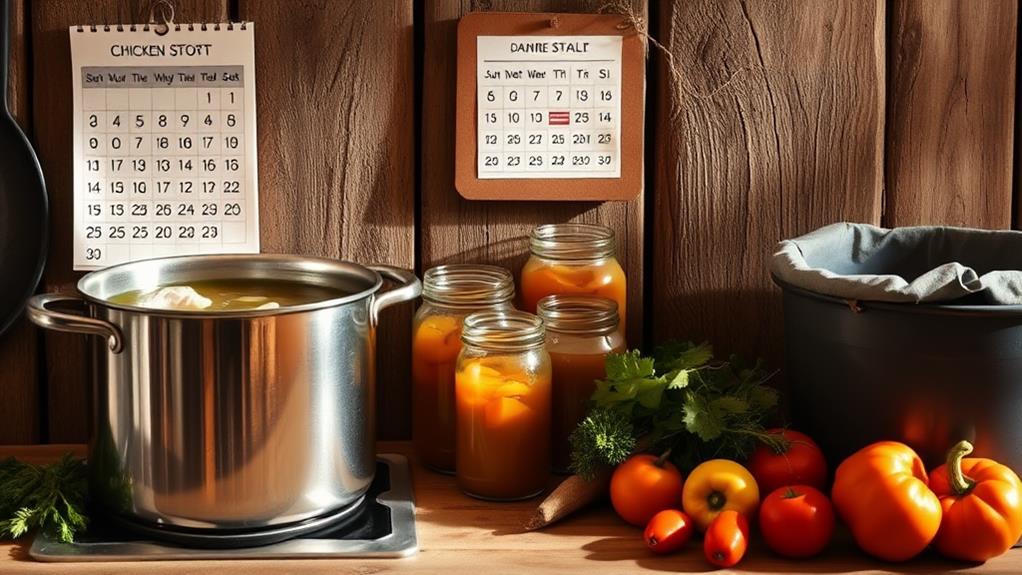Chicken stock can last up to a year if unopened, but once you open it, you need to refrigerate it right away. It's safe to use for about 4-5 days, though proper storage can extend that to 5-14 days. To avoid waste, you might want to freeze any leftover stock in ice cube trays or airtight containers, where it can last for up to three months. Check for signs of spoilage, like foul odors or discoloration, before using. By managing your stock wisely, you can cook delicious meals and minimize waste—there's more to explore on making the most of your kitchen!
Understanding Chicken Stock Types
When it comes to understanding chicken stock types, it's vital to recognize the key differences that set them apart. Chicken stock is a flavorful liquid made primarily from simmering chicken bones, vegetables, and aromatics, resulting in a rich, gelatinous consistency.
In contrast, store-bought chicken broth is typically made from meat and doesn't contain bones, which means it lacks that deep, hearty flavor and gelatinous texture. Budgeting tools can help guarantee you have the right ingredients on hand to make homemade stock, contributing to healthier meals and reducing waste.
Another significant difference lies in the cooking time. Stock is simmered for a longer duration, anywhere from 1 to 12 hours, allowing for greater flavor extraction and nutrient availability.
On the other hand, broth cooks in a shorter time, making it a quicker option.
When shopping, you'll find variations like low-sodium and organic chicken stock, catering to different dietary needs. It's important to read labels, especially for store-bought options, since they often contain additives like yeast extract and natural flavorings to enhance taste.
Homemade stock, in contrast, is free from preservatives and artificial ingredients, making it a healthier choice. By understanding these differences, you can choose the right product for your culinary needs.
Shelf Life of Boxed Stock
Boxed chicken stock typically lasts quite a while, making it a convenient pantry staple. When unopened, store-bought stock can remain good for up to one year past the printed date, as long as you store it in a dry, cool place. This extended shelf life means you can keep a few cartons on hand without worrying about them expiring too soon.
Additionally, just like managing expenses with tools that offer enhanced accuracy, keeping track of your pantry staples can help minimize food waste.
Once you open the stock, though, things change. It's important to refrigerate it immediately, as opened chicken stock is generally safe to consume for 4-5 days, according to USDA guidelines. Depending on how well it's been stored, opened stock may last anywhere from 5 to 14 days in the fridge. To keep track of freshness, you should label the carton with the date you opened it.
If you find you can't use the stock within that timeframe, consider freezing it. Freezing helps maintain quality, allowing the stock to last for up to three months. By understanding the shelf life of boxed stock, you can avoid food waste and make the most of your pantry items.
Storage Tips for Opened Broth

After opening chicken stock, it's important to store it properly to maintain its freshness. If you've opened a box of store-bought chicken stock, refrigerate it immediately. According to USDA guidelines, opened stock can last for 4-5 days in the fridge.
To maximize its shelf life, reseal the stock tightly and place it in the coolest area of your fridge, avoiding the door where temperatures fluctuate. Utilizing efficient storage methods can help reduce food waste, much like how expense tracking tools assist entrepreneurs in managing finances effectively.
Label the container with the date you opened it. This way, you can easily track its freshness and avoid using expired stock. If you don't plan to use the opened stock within 4-5 days, consider transferring it to a freezer-safe container. This method extends its shelf life to 2-3 months, giving you more flexibility in your meal planning.
Regularly check the integrity of the packaging. If you notice any off smells, discoloration, or mold, it's best to discard the stock.
Signs of Spoilage
Several telltale signs can indicate that your chicken stock has spoiled, and it's crucial to recognize them before using it. Regular reviews of your food inventory, similar to how you'd monitor savings and investments, can help prevent waste.
A foul or sour odor is a primary indicator of spoilage; if you catch a whiff of something off, it's best to discard the stock. Additionally, cloudiness or discoloration often suggests deterioration, signaling that it's no longer safe to consume.
Mold can be tricky to spot, especially if your stock's in an opaque container, so always inspect it thoroughly. If you see any mold, don't risk it—throw it out.
Another rule of thumb is to think about discarding opened chicken stock if it's been in your fridge for more than four days, even if it looks and smells fine. Remember, a fresh chicken smell is normal, but any off-putting odors or flavors indicate spoilage.
To guarantee you always have good chicken stock on hand, keep an eye out for these signs. Trust your senses: when in doubt, it's safer to toss it than to risk your health.
Freezing Chicken Stock

Freezing chicken stock is a great way to extend its shelf life and maintain quality.
To make it convenient, consider portioning your stock into freezer-safe containers or zip-top bags, allowing for easy thawing later.
By utilizing effective budgeting and expense tracking tools, you can save money on ingredients and reduce food waste by ensuring you use your stock before it spoils.
Remember to leave space for expansion, and you'll have ready-to-use stock on hand whenever you need it.
Best Freezing Practices
To preserve the freshness and flavor of your chicken stock, it's essential to freeze it properly. Start by using airtight containers or freezer-safe zip-top bags to store your homemade chicken. Remember to leave some space for expansion as the liquid freezes, which helps prevent any container from bursting.
A great freezing practice is to portion your stock into ice cube trays before freezing. This method allows you to easily thaw just what you need for a recipe, making meal preparation more convenient.
Chicken stock can maintain its quality in the freezer for about six months, but it remains safe indefinitely if kept at a consistent freezing temperature.
When it's time to thaw your frozen chicken stock, do it in the refrigerator or under cold water rather than at room temperature to avoid bacterial growth.
Also, don't forget to label your containers with the date of freezing. This simple step helps you track freshness and guarantees you use the stock within its ideal timeframe.
Portioning for Convenience
Properly portioning your chicken stock not only maximizes storage efficiency but also enhances your cooking experience. By freezing chicken stock in ice cube trays, you can easily grab the exact amount you need for your recipes, eliminating excess and reducing food waste.
Once frozen, transfer the stock cubes to a resealable plastic bag for compact storage, and don't forget to label it with the date to keep track of freshness.
To make the most of your stock, consider portioning it into smaller containers as well. This approach helps guarantee you can use your stock within the recommended 2-3 months in the freezer without any waste.
Remember to leave some space at the top of each container; as the stock freezes, it expands, and this prevents any container rupture.
When you're ready to use your frozen stock, quick thawing is simple. Just place the cubes in a saucepan over low heat or submerge the sealed bag in cold water until softened.
With these tips, portioning for convenience becomes a smart way to manage your chicken stock, making cooking effortless and reducing food waste in your kitchen.
Homemade vs. Store-Bought
When it comes to chicken stock, the choice between homemade and store-bought can greatly impact your cooking experience. Homemade chicken broth requires several hours of simmering chicken and aromatics, resulting in a rich flavor and thick consistency that you just can't replicate with store-bought chicken stock.
While the latter is convenient and ready to use right after opening, it often lacks the depth of flavor and nutrients found in homemade options. Utilizing tools to monitor your spending on ingredients can help you invest wisely in quality components for your broth, fostering better decision-making regarding your budget and culinary pursuits effective management of spending and debt repayment.
You'll appreciate how homemade broth can be customized with fresh, quality ingredients, allowing you to control the taste and health benefits. Store-bought varieties usually contain basic ingredients like water, salt, and natural flavoring, which may leave you wanting more.
Plus, homemade broth retains its quality better when reduced, thickening and intensifying the flavors, whereas store-bought broth tends to remain thin.
If you're short on time, store-bought chicken stock is a quick solution, lasting up to a year unopened. However, if you prioritize taste and nutrition, investing the time to make homemade chicken broth is worth it.
Ultimately, your choice shapes your dishes and culinary satisfaction.
Cost-Effective Stock Solutions

Finding cost-effective stock solutions can enhance your cooking experience without breaking the bank. When it comes to chicken stock, purchasing smaller packages can help you avoid waste, especially if you don't use stock often.
Larger containers might seem more economical, but they can spoil before you finish them. To maximize savings, consider utilizing price comparison tools for better deals on chicken stock and other kitchen essentials.
If you regularly cook with stock, bulk purchasing might save you money, but be cautious about spoilage. Always compare prices per volume between different sizes to guarantee you're getting the best deal without compromising quality.
Boxed chicken stock is a convenient option that often provides good value for money. However, for an even more cost-effective alternative, consider stock pastes like Better Than Bouillon.
These pastes can last over a year, allowing you to control portions based on your recipe needs and reduce waste.
Utilizing Leftovers Effectively
Make the most of your leftover chicken stock by incorporating it into a variety of delicious dishes. It's perfect for soups, stews, and sauces, enhancing both flavor and nutrition. Instead of using water, boil quinoa or rice in chicken stock for an extra depth of flavor that'll elevate your meals. You can also use leftover stock as a base for casseroles or to braise meats like barbacoa, infusing them with savory goodness. Additionally, consider utilizing coupon codes to save on ingredients, ensuring your meals remain budget-friendly.
Don't overlook how chicken stock can transform your sides, too. Mix it into mashed potatoes or vegetable purees for a creamy texture and added nutrients. It's a simple way to make everyday dishes taste gourmet.
To minimize waste, freeze any unused stock in airtight containers or ice cube trays. This method allows for easy portioning and extends its shelf life to 2-3 months, so you always have it on hand when inspiration strikes.
With these strategies, you'll not only reduce food waste but also create delicious meals that make your cooking shine. So, explore your fridge and get creative with your leftover chicken stock!
Ethical Sourcing of Ingredients

Using leftover chicken stock not only enhances your meals but also opens up a conversation about the ingredients you choose to use. When it comes to making stock, consider the ethical sourcing of your ingredients. Sourcing organic bones is essential, as it helps you avoid harmful toxins, including heavy metals and antibiotic residues commonly found in conventionally raised animals.
Ethical meat suppliers often provide pasture-raised options, which contribute to better animal welfare and sustainable practices. You can find these ethically sourced ingredients at local health shops and specialty butchers, which often have connections to farms prioritizing humane treatment.
By purchasing from local farmers or community-supported agriculture (CSA) programs, you support ethical sourcing and enhance the quality of your homemade stock. Additionally, utilizing the entire chicken, including bones and scraps, promotes a zero-waste approach to cooking, ensuring that all parts of the animal are effectively used.
With a focus on ethical sourcing, you not only create delicious chicken stock but also contribute to a more sustainable food system that respects animal welfare and the environment.
Enhancing Stock With Additives
You can easily enhance your chicken stock by adding flavor-boosting ingredients like herbs and umami-rich items.
Incorporating nutritional enhancements, such as vinegar or mushrooms, won't only elevate the taste but also improve its health benefits.
Get creative with your combinations to craft a stock that's uniquely yours!
Flavor Boosting Ingredients
A pot of simmering chicken stock can transform into a flavor powerhouse with the right additives. To elevate your stock, start by adding flavor boosting ingredients like aromatics. Garlic, thyme, and bay leaves infuse the broth with a complex taste, enriching its overall profile.
For a touch of brightness, incorporate a splash of white wine or vinegar; these ingredients balance the richness and deepen the flavor.
Umami-rich components, such as mushrooms, yeast extract, or miso paste, are fantastic for deepening the savory notes in your stock.
Don't forget about roasting your bones and vegetables beforehand—this step develops a richer, caramelized flavor that enhances your finished broth.
If you're seeking a hint of sweetness and acidity, consider adding a small amount of tomato paste. It harmonizes beautifully with the other flavors, creating an inviting depth.
By using these flavor boosting ingredients, you'll not only make broth that's delicious but also one that can stand on its own in recipes or as a base for soups.
Nutritional Enhancements
Boosting the flavor of chicken stock isn't just about taste; it's also an opportunity to enhance its nutritional value. When making chicken broth, consider adding fresh herbs like thyme, rosemary, or parsley. These not only elevate the flavor but also pack in vitamins and antioxidants.
Incorporating vegetables such as garlic, carrots, and celery will improve the broth's taste while increasing its fiber, vitamin, and mineral content.
Don't forget to use apple cider vinegar during the cooking process. This ingredient helps extract more minerals from the bones, enriching the nutritional profile of your broth.
Additionally, introducing seaweed like kombu adds iodine and other trace minerals, making your chicken stock even more beneficial.
For an extra health boost, stir in nutritional yeast after cooking. This addition brings B vitamins and a savory umami flavor, transforming your chicken broth into a nutrient-rich powerhouse.
Creative Additive Combinations
Creative combinations of additives can elevate your chicken stock from basic to extraordinary. To enrich the flavor, consider adding dried mushrooms like shiitake. They enhance the umami profile, making your stock richer and more savory.
Don't forget to toss in fresh herbs such as thyme, rosemary, or parsley. These infuse your stock with aromatic qualities and depth.
A splash of acid, like lemon juice or apple cider vinegar, brightens the taste and helps extract minerals from the bones in homemade stock.
Want to add a warming spice? Incorporate garlic and ginger; both offer health benefits and anti-inflammatory properties.
For a sweeter, more complex flavor profile, include roasted vegetables like caramelized onions or sweet potatoes.
These creative additive combinations not only improve the taste but also guarantee that you maximize your ingredients, reducing waste.
Conclusion
To sum up, knowing how long chicken stock lasts can save you money and reduce waste. Did you know that nearly 40% of food in the U.S. goes uneaten? By properly storing your stock and utilizing leftovers, you can contribute to cutting down that statistic. Whether you're using boxed stock or homemade varieties, a little awareness goes a long way in keeping your kitchen sustainable and efficient. So, let's make every drop count!



